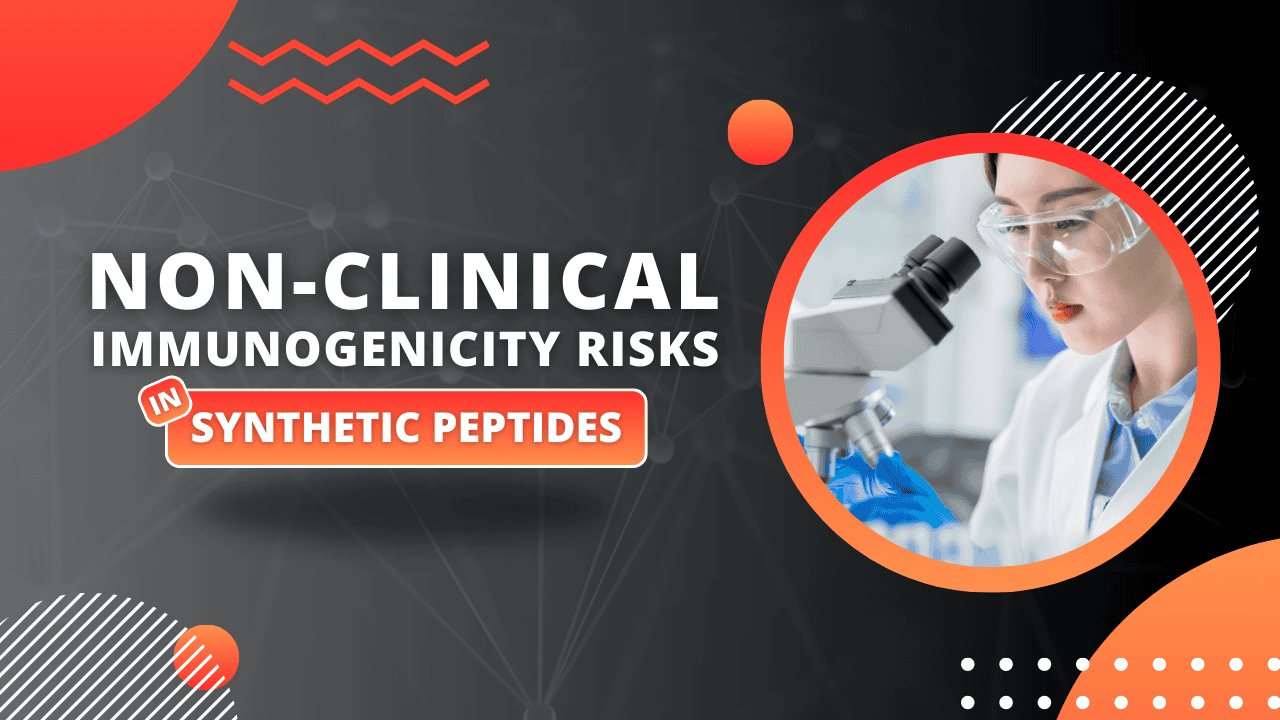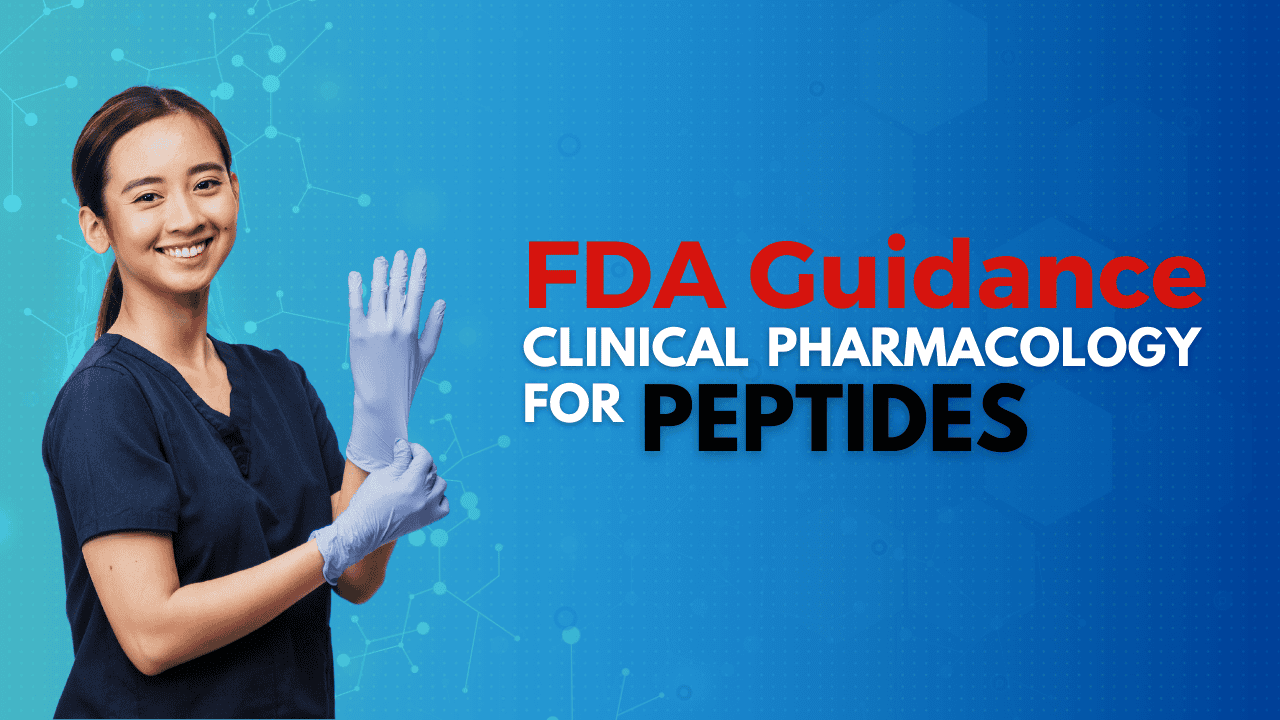

Peptides have become a significant player in modern medicine, heralding exciting advances in therapies that range from antimicrobial applications to cancer treatments.
However, the journey from laboratory discovery to clinical application is fraught with challenges, primarily concerning the toxicity of biologically active peptides.
This article will guide you through understanding these risks, from peptide drug delivery systems to the therapeutic potential these small biomolecules promise.
Peptides, which are fragments of proteins, play diverse roles in various biological processes. Derived from both natural peptide sources and synthetic peptide chains, they influence numerous physiological activities of peptides within the body. By examining the characteristics of peptides, including their size, structure, and sequence, scientists can predict their biological activity.
Biologically active peptides are encoded within larger protein structures. When these larger proteins are cleaved, the resulting biologically active peptides can interact with cellular receptors, modulating various biological pathways. The activity of peptides depends largely on their specific sequences and the context in which they act, with some serving as hormones, while others act as antimicrobial peptide agents.
Understanding the difference between peptide and protein toxicities is crucial. While proteins are large, complex molecules, peptides are smaller and more prone to degradation. This susceptibility can reduce their toxicity compared to larger proteins but can also affect their stability and efficacy as therapeutic agents. This balance between efficacy and safety is a central theme in drug discovery and development involving peptides.
The toxicity of peptides often hinges on their structure. Simple changes in side chains or peptide sequence can significantly alter their biological activity and potential toxicity. Solid-phase peptide synthesis allows for precise manipulation of peptide structures, but careful evaluation is necessary to ensure that modifications do not inadvertently create toxic peptides.
Not all peptides are toxic, but the risk is present. Some naturally occurring peptides display low toxicity and show promise as therapeutic peptides. The key lies in understanding which peptides are non-toxic and which ones pose risks. Biologically active peptides were evaluated over time, revealing that many peptides are undergoing preclinical studies, showing both potential benefits and dangers.
Peptides have emerged as attractive therapeutic agents due to their specificity and minimal side effects. Peptides often exhibit fewer side effects compared to traditional small-molecule drugs. Their therapeutic potential spans a wide range of applications, including anticancer peptide therapies and antimicrobial peptides.
Peptide therapeutics must undergo rigorous safety evaluations. The potential toxicity of biologically active peptides is a primary concern, with therapeutic peptides and proteins being scrutinized for immunogenicity and toxicities of peptides. The food and drug administration oversees these evaluations to ensure patient safety.
The future looks bright for peptide therapeutics. With advancements in drug discovery and development, including peptide drug discovery, the next generation of peptide drugs could revolutionize treatment protocols. Hundreds of peptides are undergoing clinical trials, paving the way for new therapeutic applications.
Safety is paramount when it comes to therapeutic peptides. Their safety profiles are rigorously tested, ensuring that they show negligible toxicity while maintaining efficacy. Advances in peptide synthesis and modification techniques aim to improve peptide stability, reducing their degradation and potential harmful effects.
The mechanisms by which therapeutic peptides function are diverse. Some interact directly with cell receptors, while others serve as cell-penetrating peptides, delivering active pharmaceutical ingredients directly to target cells. Each mechanism carries its own risks and rewards, requiring careful assessment during the drug development process.
Long-term use of therapeutic peptides poses potential risks. Continuous monitoring of patients using these treatments is essential to identify any delayed effects or side effects. Through diligent research and development, the field aims to uncover and mitigate these risks, ensuring safe and effective peptide-based therapies.
Proteins and peptides interact through complex biochemical pathways. These interactions can enhance or hinder the efficacy of therapeutic applications, depending on the specific context. Understanding these dynamics is crucial in designing effective peptide-based drugs.
Yes, interactions between proteins and peptides can sometimes cause toxicity. The immune system might recognize these peptide-protein complexes as foreign, leading to potential adverse reactions. Evaluating these interactions is a critical step in the development of safe therapeutic peptides and products.
During drug development, analyzing the interactions of the peptides and proteins can provide valuable insights. Techniques such as solid-phase peptide synthesis and computational modelling help researchers predict and test these interactions, ideally minimizing toxicity.
Innovations such as solid-phase peptide synthesis and advanced computational drug discovery tools are enhancing the safety of peptide drugs. These technologies allow for precise tailoring of peptide structures, reducing unwanted side effects and enhancing therapeutic efficacy.
Numerous case studies highlight the success of safe peptide drugs. From antimicrobial peptides showing low toxicity in clinical trials to peptides used in advanced cancer therapies, these real-world examples demonstrate the potential of well-designed peptide drugs.
Modifications to peptide structures, like altering peptide sequences or adding side chains, can greatly influence their safety. These modifications aim to produce non-toxic peptide variants while maintaining their therapeutic activity. The synthesis of peptide modifications is a dynamic area of research, focused on optimizing safety and efficacy.
Delivering proteins and peptides effectively to their target sites remains a significant challenge. Issues such as degradation in the digestive system and poor cellular uptake complicate oral delivery of peptides. Novel drug delivery systems are being developed to overcome these hurdles.
Current drug delivery systems for peptides vary in effectiveness. Encapsulation techniques, liposome carriers, and cell-penetrating peptides are some of the strategies employed to enhance delivery. Each method has its pros and cons, and ongoing research aims to refine these systems for improved outcomes.
Innovative approaches such as nanotechnology and bioengineered carriers are emerging as promising solutions for the delivery of proteins and peptides. These technologies offer the potential to improve peptide stability, enhance bioavailability, and minimize toxicity.
While drug delivery systems improve the efficacy of peptide therapies, they also bring associated risks. Potential toxicity, immune reactions, and unexpected side effects are some concerns. Rigorous testing and evaluation are necessary to mitigate these risks.
Recent innovations in peptide drug delivery systems include the development of biodegradable carriers and targeted delivery mechanisms. These advancements aim to improve the precision and safety of delivering therapeutic peptides to specific sites within the body.
The efficacy of drug delivery systems for peptides is evaluated through preclinical and clinical testing. Researchers examine factors such as bioavailability, stability, and toxicity to determine the most effective delivery methods. Successful systems can dramatically enhance the therapeutic potential of peptides.
Short-term effects of peptides can range from mild to severe, depending on their structure and function. While many peptides exhibit therapeutic benefits, some may cause unintended effects. Monitoring these effects is crucial during the early stages of peptide drug development.
Adverse long-term effects of peptides are a concern that cannot be overlooked. Studies on the toxicity of biologically active peptides aim to identify any chronic side effects that may arise from prolonged use. Safety measures are continually refined to ensure the well-being of patients receiving peptide therapies.
To ensure safety, the effects of peptides must be meticulously monitored and measured. Clinical trials and post-market surveillance programs play key roles in tracking the efficacy and safety of peptide drugs. Ongoing research helps to refine these monitoring techniques, ensuring that patients receive the safest and most effective therapies.
Peptide drugs undergo extensive safety evaluations to ensure they do not pose significant risks. This includes in vitro and in vivo testing, toxicity studies, and clinical trials. These evaluations help identify potential toxic peptides and ensure that therapeutic peptides are safe for use.
Testing peptide drugs for toxicity involves a multi-step process. Initial screenings in cell cultures and animal models help determine acute toxicity levels. Subsequent clinical trials in humans evaluate long-term safety and effectiveness, identifying any adverse effects.
Several case studies have highlighted instances of peptide drug toxicities. These examples underscore the importance of thorough testing and safety measures. By learning from past cases, researchers can develop safer and more effective peptide therapies.
Peptides are chosen as therapeutic agents because of their specificity, potency, and reduced risk of adverse effects. Their ability to interact precisely with biological targets makes them ideal candidates for treating a variety of conditions. Moreover, peptides from natural sources are often well-tolerated by the body.
The risk-benefit ratio of using peptides as therapeutic agents is carefully analyzed. While the benefits include targeted therapy and fewer side effects, the risks involve potential toxicity and stability issues. Balancing these factors is key to successful peptide drug development.
The future for peptides as therapeutic agents is bright, with ongoing research into novel peptide structures and delivery methods. Innovations in peptide synthesis and modification continue to expand the range of conditions that peptide therapies can address, offering new hope for patients worldwide.
Therapeutic proteins and peptides differ primarily in their size and complexity. Proteins are large, intricate molecules, whereas peptides are shorter chains of amino acids. Understanding these differences helps in designing appropriate therapeutic applications for each type.
Combining therapeutic proteins and peptides can enhance the efficacy of treatments. These combinations can offer synergistic effects, improving patient outcomes. Evaluating these combined treatments involves rigorous testing to ensure safety and effectiveness.
Safety measures for therapeutic proteins and peptides include extensive preclinical and clinical testing, stringent regulatory oversight, and continuous monitoring of patients. These measures aim to identify and mitigate any potential risks associated with these treatments.
Risk management strategies for peptide therapies include comprehensive safety evaluations, regulatory compliance, and ongoing monitoring. These strategies help identify potential risks early, allowing for timely intervention and mitigation.
Implementing safety protocols involves establishing standardized procedures for testing, manufacturing, and administering peptide therapies. These protocols ensure that each stage of development and use meets stringent safety criteria, protecting patients from potential harms.
Effective risk management in peptide therapies is demonstrated through various case studies. These examples show how comprehensive safety measures and proactive risk management can lead to successful outcomes, minimizing the risks associated with peptide treatments.
Emerging trends in safety for peptide use include advanced computational modeling, personalized medicine approaches, and innovative delivery systems. These trends are shaping the future of peptide therapies, enhancing their safety and efficacy.
Predicting future risks involves exploring potential long-term effects and unforeseen adverse reactions. Through continuous research and vigilance, scientists aim to identify and mitigate these risks, ensuring the ongoing safety of peptide therapies.
Policy and regulation changes are crucial for ensuring the safety of peptide therapies. Evolving guidelines and stricter regulations help maintain high safety standards, protecting patients and fostering trust in peptide-based treatments.
Biologically active peptides have caused toxicity in some cases, leading to adverse reactions. Analyzing these instances helps researchers understand the underlying causes and develop strategies to avoid similar issues in the future.
Lessons learned from historical peptide toxicities include the importance of thorough testing, careful modification, and vigilant monitoring. These lessons guide current and future peptide drug development, aiming to improve safety and efficacy.
Applying lessons from past experiences involves integrating safety measures into every stage of peptide development. This proactive approach helps minimize risks, ensuring that new peptide therapies are both effective and safe for patients.
Recent innovations in peptide safety technologies include advanced synthesis methods, computational modeling, and targeted delivery systems. These technologies enhance the safety and effectiveness of peptide therapies.
Innovations in peptide technologies aim to reduce toxicity by improving stability, enhancing targeted delivery, and minimizing adverse reactions. These advancements help create safer and more effective peptide-based treatments.
Evaluating the effectiveness of new technologies involves rigorous testing and validation. By assessing the impact of these innovations on safety and efficacy, researchers can ensure that new peptide therapies meet the highest standards of care.
Educating medical professionals about peptide toxicity involves comprehensive training programs, continuous education, and access to up-to-date research. These efforts equip healthcare providers with the knowledge needed to safely administer peptide therapies.
Training programs for safe peptide use include specialized courses, workshops, and certifications. These programs cover various aspects of peptide therapy, including safety protocols, risk management, and patient monitoring.
Evaluating the impact of education on peptide safety involves monitoring clinical outcomes and gathering feedback from healthcare providers. Continuous improvement of educational programs ensures that medical professionals remain well-informed and capable of delivering safe peptide treatments.
Key areas for future research on peptide toxicity include understanding long-term effects, developing non-toxic peptide variants, and exploring novel delivery methods. These research efforts aim to enhance the safety and efficacy of peptide therapies.
Future research can mitigate the risks of peptides by focusing on precise modifications, advanced testing methods, and innovative safety protocols. Collaborative efforts among scientists, healthcare providers, and regulatory agencies will drive these advancements.
Innovation and collaboration are essential for advancing peptide research. By bringing together diverse expertise and resources, researchers can overcome challenges and unlock the full therapeutic potential of peptides.
Peptide therapies promise exciting advances in medicine, but their development requires careful attention to safety and efficacy. By continually refining our understanding and approaches, we can harness the full potential of peptides for better patient outcomes.
Yes, peptides can be toxic. Certain bioactive peptides may interact with cellular mechanisms in ways that lead to adverse effects. Toxicity often depends on the peptide sequence and structure, with cyclic peptides sometimes presenting higher risks if not designed well.
Peptides can be harmful if they induce unintended biological reactions. High toxicity in certain peptides has been documented, which underscores the need for thorough clinical evaluations before they are used as therapeutic agents.
One significant drawback of peptides is their instability in the body, which can lead to rapid degradation and reduced effectiveness. Additionally, peptides are prone to eliciting immune responses, potentially causing side effects.
Peptides are not universally illegal, but some may not be FDA approved due to a lack of sufficient safety and efficacy data. The illegal status of certain peptides often stems from inadequate regulation and misuse in non-medical contexts.
Yes, there can be downsides to taking peptides, including potential side effects like immune reactions and the risk of toxicity. Peptides often exhibit short half-lives, requiring frequent dosing to maintain therapeutic levels.
Peptides influence the body by interacting with specific cellular receptors, modulating biological processes. Peptides are fragments of proteins that can act as hormones, enzymes, or signaling molecules, affecting metabolism, growth, and immune response.
Peptides are generally considered safer than steroids because they tend to have fewer severe side effects. Unlike steroids, peptides can offer targeted therapeutic benefits without the extensive physiological impacts associated with steroid use.
Peptides might not be FDA approved if they lack sufficient clinical evidence proving their safety and efficacy. The FDA requires rigorous testing and data before approving any drug candidate, including peptides.
Peptides can be bad for you if they are improperly formulated or used without medical supervision. Risks include immune reactions, toxicity, and potential interference with normal physiological functions.
Peptides are not universally illegal in the USA, but many are regulated and require FDA approval for medical use. Unsanctioned use of research-grade peptides can result in legal implications.
Dr. David J. Craik is a distinguished expert in the field of peptide science, renowned for his groundbreaking work on cyclic peptides and their therapeutic potential. With over 30 years of experience in peptide research, Dr. Craik has significantly contributed to our understanding of peptide stability and bioactivity. His innovative research on cyclotides, a unique class of cyclic peptides, has paved the way for new drug discovery and development strategies.
Dr. Craik’s notable publications include:
Dr. Craik’s work is characterized by its innovative approach and meticulous methodology, earning him recognition and respect in the scientific community. He has received numerous awards, including the prestigious David Craig Medal from the Australian Academy of Science, underscoring his authority and trustworthiness in peptide research.
Dr. Philip E. Dawson is a leading researcher in peptide science, known for his pioneering work in the synthesis and application of bioactive peptides. With a background in chemistry and extensive experience in peptide synthesis, Dr. Dawson has advanced our knowledge of peptide therapeutic development through innovative synthesis techniques and collaborative research efforts.
Key publications by Dr. Dawson include:
Dr. Dawson’s contributions to peptide science are marked by his commitment to innovation and precision. His research has not only advanced the field of peptide synthesis but also contributed to the development of peptide-based therapeutics. Dr. Dawson has been honored with several prestigious awards, including the Vincent du Vigneaud Award from the American Peptide Society, further attesting to his expertise and the impact of his work.
Hoppmann, C., Barucker, C., Lorenz, D., Multhaup, G., & Beyermann, M. (2012). Light‐Controlled toxicity of engineered amyloid Β‐Peptides. ChemBioChem, 13(18), 2657–2660. https://doi.org/10.1002/cbic.201200605
Saini, R. K., Goyal, D., & Goyal, B. (2020). Targeting human islet amyloid polypeptide aggregation and toxicity in Type 2 diabetes: An Overview of Peptide-Based Inhibitors. Chemical Research in Toxicology, 33(11), 2719–2738. https://doi.org/10.1021/acs.chemrestox.0c00416
Suhorutsenko, J., Oskolkov, N., Arukuusk, P., Kurrikoff, K., Eriste, E., Copolovici, D., & Langel, Ü. (2011). Cell-Penetrating peptides, PEPFECTs, show no evidence of toxicity and immunogenicity in vitro and in vivo. Bioconjugate Chemistry, 22(11), 2255–2262. https://doi.org/10.1021/bc200293d
ALL ARTICLES AND PRODUCT INFORMATION PROVIDED ON THIS WEBSITE ARE FOR INFORMATIONAL AND EDUCATIONAL PURPOSES ONLY. The products offered on this website are intended solely for research and laboratory use. These products are not intended for human or animal consumption. They are not medicines or drugs and have not been evaluated or approved by the FDA to diagnose, treat, cure, or prevent any disease or medical condition. Any form of bodily introduction is strictly prohibited by law.




Discount Applied Successfully!
Your savings have been added to the cart.